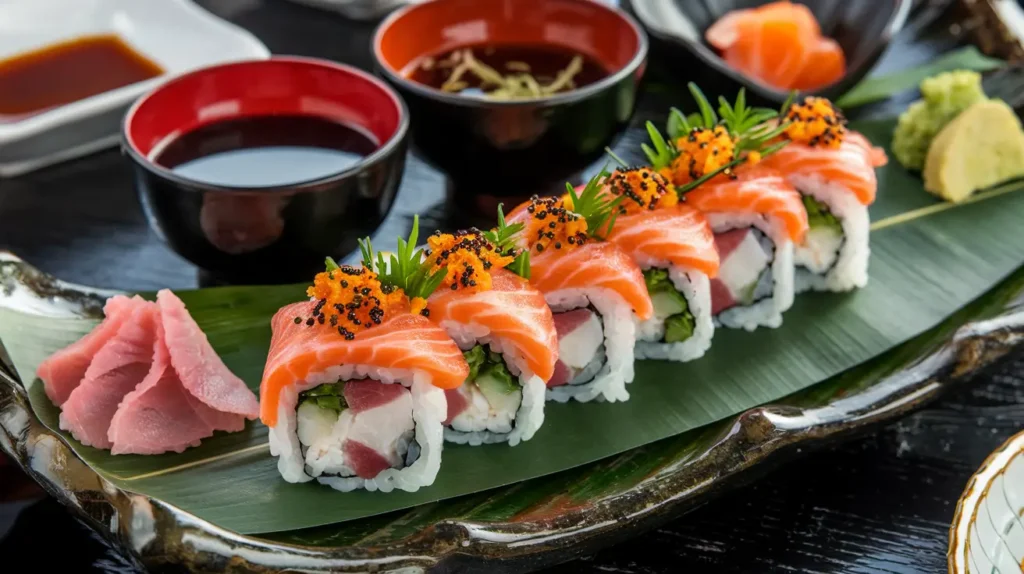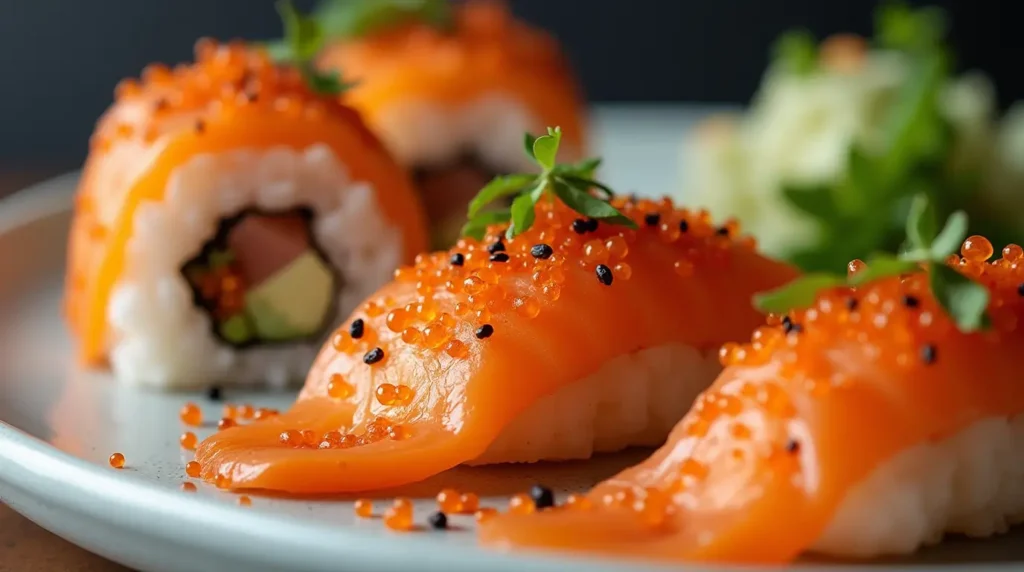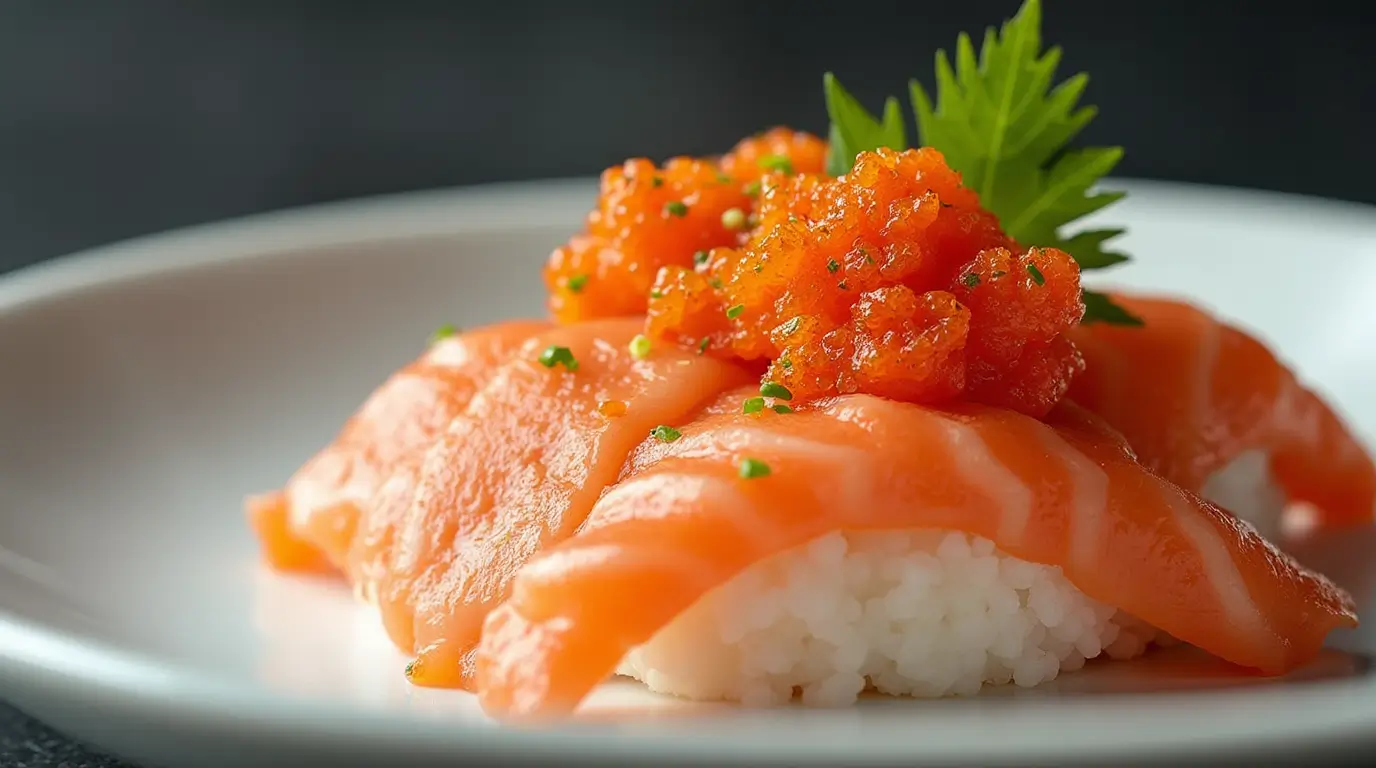Table of Contents
Tobiko nutrition has become increasingly popular in modern cuisine, featuring prominently in Japanese and fusion dishes. These small, vibrant orange eggs from flying fish offer a delightful pop of texture and a subtle smoky-salt flavor that enhances various dishes.
Originally prized in Japanese cuisine, tobiko has gained global recognition for its versatility and nutritional benefits. Its distinctive appearance and unique texture make it a sought-after ingredient in sushi rolls, seafood dishes, and contemporary fusion creations.
Comprehensive Nutritional Profile of Tobiko
The tobiko nutrition profile stands out for its impressive array of essential nutrients. These small but mighty fish eggs pack a powerful nutritional punch, offering high-quality protein and beneficial omega-3 fatty acids that surpass many common seafood options.
Daily consumption of just two tablespoons of tobiko can contribute significantly to your recommended daily intake of several vital nutrients. The natural composition of tobiko makes it an excellent choice for those seeking whole-food nutrition sources.
Key nutritional components per 100g serving:
- Protein: 28g (complete protein with all essential amino acids)
- Omega-3 fatty acids: 1.8g (including EPA and DHA)
- Vitamin B12: 8.7mcg (363% of daily value)
- Selenium: 25mcg (45% of daily value)
- Iron: 4mg (22% of daily value)
- Vitamin D: 3mcg (15% of daily value)
- Calcium: 120mg (12% of daily value)
- Calories: 160
- Sodium: 340mg
- Phosphorus: 400mg
- Magnesium: 48mg
Key Health Benefits of Tobiko Consumption
1. Heart Health Support
Tobiko nutrition contributes significantly to cardiovascular health through its rich omega-3 content. These essential fatty acids help reduce inflammation and support healthy cholesterol levels.
2. Brain Function Enhancement
The combination of omega-3s and vitamin B12 in tobiko supports cognitive function and neural development. Regular consumption may help maintain mental clarity and memory function.
3. Immune System Boost
Packed with selenium and other antioxidants, tobiko nutrition helps strengthen the immune system. These compounds protect cells from damage and support overall immune function.
4. Protein-Rich Source
As a complete protein source, tobiko provides all essential amino acids. This makes it an excellent choice for maintaining muscle health and supporting overall body function.

5. Eye Health Promotion
The vitamin A content in tobiko supports vision health and helps protect against age-related eye conditions. Regular consumption may contribute to better night vision.
6. Bone Health Support
Tobiko nutrition includes essential minerals that contribute to bone density. The calcium and vitamin D content helps maintain strong, healthy bones.
7. Energy Enhancement
The B-vitamin complex found in tobiko helps convert food into energy. This makes it an excellent choice for maintaining steady energy levels throughout the day.
Culinary Applications: Incorporating Tobiko into Your Meals

Transform ordinary dishes into gourmet experiences with tobiko nutrition. Here are several creative ways to incorporate this nutritious ingredient:
Traditional Applications:
- Sushi rolls (maki and uramaki)
- Nigiri toppings
- Chirashi bowls
- Temaki hand rolls
Modern Fusion Ideas:
- Avocado toast with tobiko garnish
- Seafood pasta with tobiko finish
- Poke bowls
- Asian-inspired salads
- Canapés and appetizers
Quick Tobiko Rice Bowl Recipe:
- Cook sushi rice according to package instructions
- Top with fresh cucumber, avocado, and tobiko
- Drizzle with soy sauce and sesame oil
- Garnish with nori strips and sesame seeds
- Optional: add protein like seared tuna or tofu
Advanced Tobiko Recipes:
- Tobiko Deviled Eggs:
- Prepare classic deviled eggs
- Mix tobiko into the yolk filling
- Garnish with additional tobiko and chives
- Tobiko Cream Cheese Spread:
- Blend softened cream cheese with wasabi
- Fold in tobiko
- Serve with crackers or bagels
Considerations and Potential Risks
While tobiko nutrition offers numerous benefits, certain considerations exist:
Allergies and Sensitivities:
- Those with shellfish allergies should exercise caution
- Cross-contamination risks during processing
- Potential iodine sensitivity concerns
Dietary Restrictions:
- Pregnancy considerations
- Religious dietary laws
- Sodium content monitoring
- Mercury levels (generally very low compared to larger fish)
Storage and Safety:
- Proper temperature control
- Fresh storage guidelines
- Quality indicators
- Safe handling practices
FAQs
Q: What does tobiko taste like? A: Tobiko has a mild, smoky-salty flavor with a satisfying pop when eaten.
Q: How should I store tobiko? A: Keep tobiko refrigerated and consume within 2-3 days after opening.
Q: Is tobiko nutrition suitable for a keto diet? A: Yes, tobiko is low in carbohydrates and high in healthy fats, making it keto-friendly.
Q: Can I eat tobiko raw? A: Yes, tobiko is typically consumed raw and is safe when properly handled and stored.
Q: How many calories are in a typical serving of tobiko? A: A standard serving (1 ounce/28g) of tobiko contains approximately 40-45 calories, making it a lightweight addition to your meals.
Q: Can I freeze tobiko? A: While fresh tobiko is preferred, you can freeze it for up to 2 months. Store in an airtight container and thaw in the refrigerator overnight before use.
Q: What makes tobiko different from other fish roe? A: Tobiko nutrition stands out for its unique combination of nutrients, smaller size compared to salmon roe, and distinctive crunchy texture. It’s also naturally orange in color.
Q: Are there different varieties of tobiko? A: Yes, besides the traditional orange tobiko, you can find black (infused with squid ink), red (infused with chili), green (infused with wasabi), and yellow (infused with citrus) varieties.
Tips for Buying and Storing Tobiko
When purchasing tobiko, look for vibrant color and fresh ocean scent. Quality tobiko nutrition starts with proper selection and storage. Choose reputable suppliers and ensure proper refrigeration throughout transportation and storage.
Store tobiko in an airtight container in the refrigerator at 35-40°F (2-4°C). Proper storage helps maintain both nutritional value and food safety standards. Always check the expiration date and use within the recommended timeframe.
Conclusion: Embracing Tobiko for a Nutritious Diet
The remarkable benefits of tobiko nutrition extend beyond its delightful taste and texture. This versatile ingredient represents a perfect fusion of culinary excellence and nutritional wisdom, making it an invaluable addition to contemporary healthy eating patterns.
Health-conscious individuals increasingly recognize tobiko as a premium source of essential nutrients. Its unique combination of omega-3 fatty acids, high-quality protein, and vital micronutrients positions it as a superior choice for those seeking to enhance their dietary intake naturally.
Moreover, the versatility of tobiko makes it an excellent choice for both traditional and modern cuisine. Whether you’re a seasoned chef or an adventurous home cook, incorporating tobiko into your meals can elevate both their nutritional value and gastronomic appeal.
As global cuisine continues to evolve, tobiko stands out as a testament to the enduring value of traditional Japanese ingredients. Its growing popularity in international cuisine speaks to its universal appeal and adaptability across different culinary traditions.
Related Articles
- Tobiko: Discover Its Incredible Health Benefits
- Health Benefits of Sea Vegetables
- Modern Applications of Traditional Japanese Ingredients

